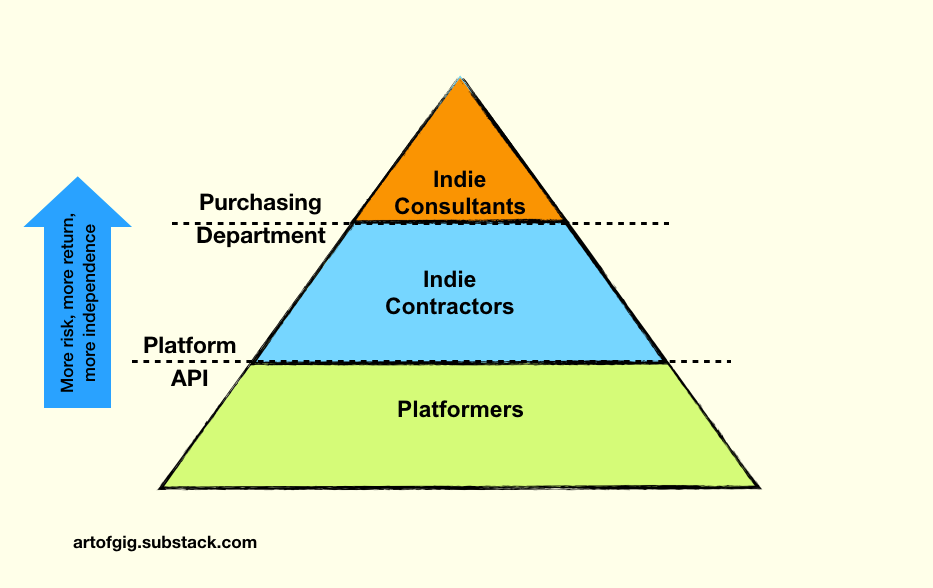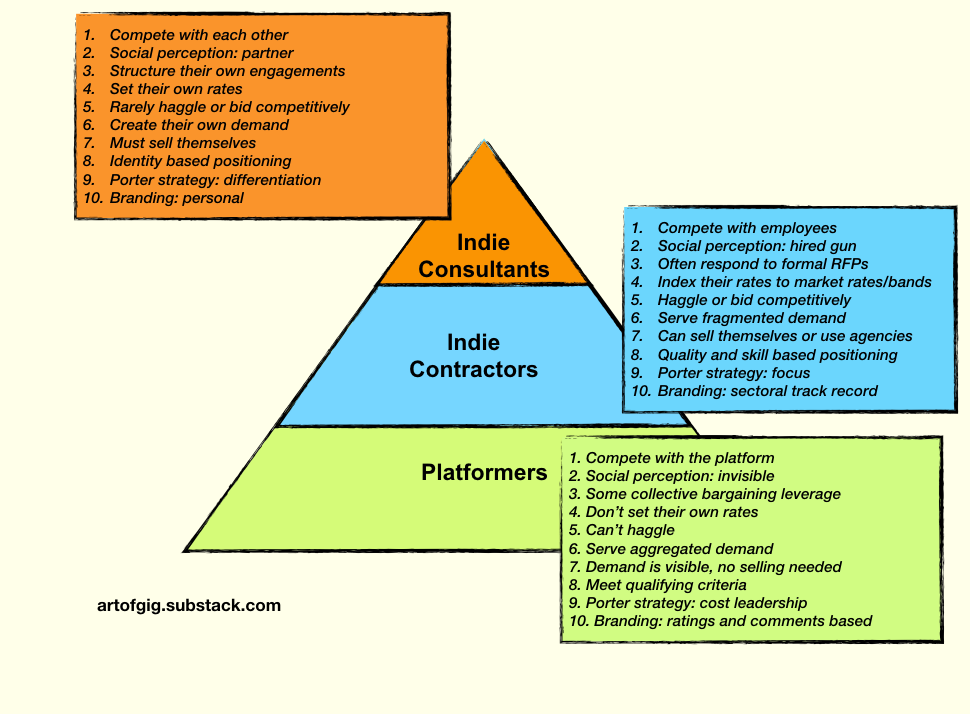Over the short history of this newsletter, I’ve been rather sloppily referring to distinctions among 3 kinds of gig economy workers: indie consultants, indie contractors, and under-the-API gigworkers, who I’m now relabeling platformers (people who find work via things like Uber or Upwork and who I can’t, with a straight face, attach the adjective indie to). I’m overdue for cleaning up my definitions of these 3 important categories and their structural relationships to each other, so here we go. First, here is the basic structure:
You’re an indie consultant if you don’t have to deal with purchasing departments (or sometimes, HR departments) as gatekeepers.
You may still need to do paperwork with them, but they have little control over whether to hire you because sufficiently senior managers or executives are making that call. In particular, if hiring freezes/cost control measures are in place, they are senior enough to authorize exceptions, OR are irreplaceable enough to get such exceptions made on their behalf via their chain of command (often this is mission-critical technical people).
You’re a contractor if a purchasing department has significant power to say no based on a variety of considerations, and the client principal can’t override that decision.
You’re an under-the-API platformer if you get work mostly on autopilot from a demand aggregator platform, with little to no human gatekeeping (you might get some procedural human attention while signing up, and during exceptional situations, but that’s it).
How are these 3 layers different? The overall difference is that you take on more risk, for more return, in the higher layers, and gain more independence if you succeed. Much of the changing risk/return profile comes from having to sell yourself to generate your own demand. The increased independence manifests as increasing control over contract terms.
This basic difference leads to all the other differences. Here are 10 important dimensions of the differences, illustrated. I’ve tried to be pretty black-and-white for clarity, but of course, there’s blurred edges along all 10 dimensions.
The ten dimensions (detailed for the 3 layers above) are:
-
Competition mode
-
Social perception
-
Contracting structure
-
Rate-setting
-
Haggling/bidding dynamics
-
Demand structure
-
Selling model
-
Positioning
-
Generic strategy type
-
Branding
For most of you, the ambiguity in who you are is likely to be between contracting and consulting. The easiest way to tell the two apart is whether or not you haggle (dimension 5). I discussed that in detail in my Aug 15, 2019 newsletter: When is a Gig an Engagement? Important point: as I noted in that article, contractors can often make more money per hour than comparable consultants. Haggling does NOT mean being paid less.
But platformers generally are paid less (far less) than either contractors or consultants, because they’re generally participating in a relatively lower skill sector. Uber-for-X generally involves low-$/hour kinds of X.
The simplest way to understand the logic of these distinctions is via Michael Porter’s famous generic strategies model (dimension 9).
-
Indie consultants use a strategy of differentiation,
-
Indie contractors use a strategy of focus,
-
Platformers use a strategy of low-cost leadership.
These things are hard to mix effectively, which is why “hybrid” strategies are dangerous unless you’re absolutely forced into them. They require incompatible operating practices and models, so if you hybridize, you’ll often find yourself making zero-sum tradeoffs. Moves that strengthen you as a contractor will weaken you as a consultant, and vice-versa. This is also why upward mobility is rare in the gig economy. You’re likely to stay at the level you’re at unless you pull a high-effort stunt to move up (for the contractor to consultant move, a good stunt is to write a book).
I imagine very few of you are in the platform layer, or if you are, it’s a temporary way to backstop cashflow shortfalls while you get the game going at either the contracting or consulting levels. But the reason I pay a lot of attention to the platform layer is that it is the strongest manifestation of “software eating the world” in the gig economy. The biggest trends in the gig economy are unfolding at the platform layer.
So you need to be paying attention to it, and open to participating in it if it opens up the right possibilities for you.

